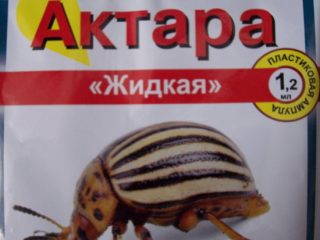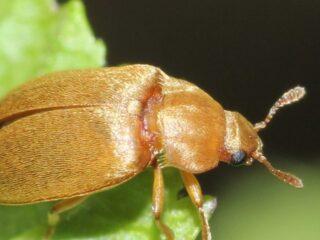Content
The raspberry fly is a dangerous pest that can cause not only a lack of harvest, but also the death of the entire raspberry tree. So that the gardener can take timely measures to destroy it, you need to know the first signs of damage. Because any delay only aggravates the problem. And then you will have to make much more effort to eliminate it.

The raspberry stem fly lays up to 90 eggs per season
What does a raspberry fly look like?
This is a small insect. The raspberry stem fly (Chortophila dentiens), as seen in the photo, resembles a midge in appearance. The length of its body does not exceed 7 mm. The color of the insect is gray-brown, the wings are transparent. The raspberry fly has three pairs of black legs.
The eggs are oval-oblong, light-colored. Their size is 3 mm. The larvae-caterpillars of the raspberry fly are dirty white in color, without legs, and move due to body contractions. The mouthparts are gnawing type. The pupae of the raspberry fly are brown in color and their length is 5-7 mm. The cocoon is barrel-shaped.
Signs of damage to bushes
A characteristic sign of raspberry stem fly damage is wilting tops of young shoots. Moreover, the loss of turgor occurs regardless of watering. Subsequently, the affected shoots acquire a bluish tint, the leaves on them begin to turn yellow from top to bottom, and then they dry out completely.
What harm does
In the spring, as soon as the soil warms up to +10 °C, sexually mature individuals of the raspberry fly emerge from the pupae. Their active years begin at the end of April or in May, depending on the climatic conditions of the region. After the mating season, female raspberry flies lay eggs in the axils of leaves on growing young shoots. After 8-9 days, small caterpillar larvae emerge from them. They bite into the shoot and feed on its core. This leads to disruption of metabolic processes in tissues. As a result, the tip of the shoot does not receive nutrition and begins to wither.
As the raspberry fly larva moves inside, the stem of the fruit bush turns black and dries out. As a result, the raspberry fly caterpillar reaches the base of the shoot and goes into the soil to pupate.
When the pest multiplies on a massive scale, most of the young growing shoots suffer, which leads to a significant reduction in yield this season for remontant raspberries and in the future for conventional crop species.

The pest initially attacks weakened plants
Reasons for appearance
There are several provoking factors that contribute to the appearance of stem flies in raspberries.
Among them:
- Close placement of blackberry, meadowsweet and meadowsweet plantings. These crops are also susceptible to stem fly attacks. And if raspberries are planted near them, sooner or later the raspberry fly moves to the neighboring area.
- Aphid. Untimely control of this pest can lead to the appearance of a stem fly, as it is attracted by copper dew. Ants contribute to the massive spread of aphids in the garden. Therefore, the fight must be waged against them.
- Lack of preventive treatments for bushes. In the spring, it is necessary to spray raspberries with insecticides during the period of swelling of the buds to prevent the appearance of pests.
- Poor quality humus and mulch. Pupated larvae can be found in organic fertilizer and peat. Using them, you can also introduce stem fly into the raspberry tree.
How to deal with raspberry fly in spring and autumn
If a raspberry is attacked by a stem fly, then urgent measures must be taken to save the fruit bush. To do this, you can use insecticides, biological preparations and folk remedies. Only integrated control methods will help get rid of the pest and maintain high crop yields.
Insecticides
Stem fly on raspberries should be controlled with special chemicals. They should be used for spraying shrubs during the growing season, as well as for watering to destroy insect larvae and pupae.
When wilted tops appear, you need to cut them off, capturing a few pieces of healthy shoots, and burn them along with the raspberry fly larvae.And only after that carry out treatment with insecticides.
The most effective means:
- Karbofos. A highly toxic drug that can be used once for treating raspberries during the period of active leaf growth, as well as spraying the soil at the base of the bushes. When using this product, increased safety precautions must be observed. Karbofos has a detrimental effect on bees. To prepare the working fluid, you need to dilute 60 g of the product in 10 liters of water.
Karbofos can be sprayed on raspberries at temperatures below 15 ° C
- Spark. Broad-spectrum systemic insecticide. To combat the raspberry fly in the spring, it can be used to water the bushes to destroy the pupae, and in the summer when signs of damage appear. To prepare the working fluid, you need to dissolve one tablet of the drug in 10 liters of water.
Spark contains two active components, which increases its effectiveness
- Aktellik. Pyrethroid insecticide belonging to the organophosphate group of drugs. The active component is pirimiphos-methyl. Actellik has an insectoacaricidal effect. The first results of application become noticeable two hours after treatment. To prepare a working liquid against raspberry flies, you need to dissolve 2 ml of the drug in 2 liters of water.
Actellik is effective against a complex of pests and also helps against ticks
- Fufanon Nova. A universal insectoacaricide belonging to the class of organophosphorus compounds. The active component is malathion, the concentration of which is 440 g per 1 liter. To prepare a working liquid against raspberry flies, you need to dissolve 10 ml of the product in 10 liters of water.It is recommended to spray berry bushes with Fufanon in the spring 2-3 weeks before flowering. The multiplicity of permissible treatments is no more than two.
Fufanon Nova has a contact effect and has a fumigation effect
Biological preparations for raspberry fly
You can also get rid of the raspberry fly using biological preparations. They are characterized by a low level of toxicity and a short waiting period. Therefore, these measures to control the raspberry fly should be applied in June, when the berries begin to ripen. However, biological products are effective at temperatures not lower than +20 °C.
Effective biological products:
- Fitoverm. This drug belongs to the category of insectoacaricidal, having a contact-intestinal effect. To treat bushes against raspberry flies, you need to dissolve 2 ml of the drug in 1 liter of water. Spraying should be carried out in the evening or in the morning in dry, windless weather.
Fitoverm cannot be used during the raspberry flowering period.
- Aktofit. The drug is a transparent liquid of a light or dark yellow hue with a specific odor. The active ingredient is aversectin. It provides safe protection for raspberries during ripening and harvesting. This bioinsecticide is not addictive and breaks down into safe components within two days after treatment. To prepare a working solution against raspberry flies, you need to dilute 4 ml of concentrate in 1 liter of water.
Aktofit does not harm the environment
Folk remedies
You need to start fighting the raspberry fly in early spring. During this period, the use of folk remedies is most relevant.With their help, you can create unfavorable conditions for the transformation of pupae into sexually mature individuals. To do this, experienced gardeners recommend loosening the top layer of soil in the raspberry field in the spring with the addition of mustard powder, wood ash or tobacco dust. All these components create an aggressive environment in the ground, which leads to the death of pupated larvae.
You can also use birch tar to repel raspberry stem flies from fruit bushes. To do this, add 10 g of this product to 10 liters of water and mix thoroughly. To ensure that the resulting solution adheres well to the leaves, it is recommended to add an additional 30 ml of liquid soap. After this, spray the bushes and the soil at their base against raspberry flies. Repeat the procedure every week.
Preventive measures
Proper and timely care of raspberries helps reduce the likelihood of stem flies appearing in the garden. But preventive measures can only give results if they are carried out regularly.
To protect the raspberry tree from pests you need:
- Avoid dense plantings and thin out growing young shoots.
- Regularly feed the bushes and treat them against diseases to maintain a high level of immunity.
- Plant garlic, marigolds, coriander, and celery next to the raspberries. The smell of these plants repels the pest.
- To combat the raspberry fly in the fall, it is necessary to promptly remove plant debris and burn it. You should also loosen the soil to a depth of 5 cm so that the raspberry fly pupae freeze out in winter.
- In the spring, you should lay mulch of humus or peat at least 8 cm thick at the base of the bushes. Not many flies will be able to overcome such a barrier when trying to get out.
- Spray raspberries with insecticides once a month at the beginning of the growing season to prevent infection.
Raspberry varieties resistant to pests
There are raspberry varieties that are resistant to the raspberry stem fly. The more pubescent the shoots of the bush, the lower the likelihood of being attacked by the pest.
Resistant varieties:
- Faith;
Vera - an early variety with small and medium berries of a purple hue
- Zorenka Altai;
Altai Zorenka is a large-fruited species included in the State Register in 1990
- Bell;
Bellflower is suitable for growing in central and northern regions
- Reward;
The tasting rating of the Reward variety is 4.5 points out of a possible five
- Balm.
Balm – aroma and taste resembles wild raspberries
Conclusion
The raspberry fly is a pest whose appearance is easier to prevent than to deal with it later. After all, even a small number of these insects can significantly reduce yields not only in the current, but also in subsequent seasons. And it will take a long time to restore the productivity of the raspberry plant.



















